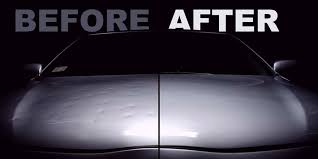
The Comprehensive Guide to Hail Dent Removal: Restoring Your Vehicle’s Pristine Look
Hailstorms can be highly unpredictable, leaving behind a trail of damage in their wake. One of the most common victims of such storms is vehicles. Hailstones can cause unsightly dents and dings that not only diminish the aesthetic appeal of your car but also potentially decrease its value. If you find yourself faced with hail damage, fear not—hail dent removal techniques have advanced significantly. This guide will walk you through the essentials of restoring your vehicle’s pristine look.
Understanding Hail Damage
Hailstones vary in size, and when they strike, they can leave anything from minor dings to large dents on your vehicle’s surface. The severity of the damage depends on factors like the size of the hailstones, the speed at which they hit, and the angle of impact. Regardless of the extent of the damage, it is essential to address it promptly to prevent further deterioration.
Why Professional Hail Dent Removal is Essential
While it might be tempting to opt for DIY solutions, professional hail dent removal offers several advantages:
1. Precision and Expertise: Professionals have the tools and expertise to restore the original look of your vehicle without causing additional damage. They undergo specialized training to handle various dent sizes and shapes effectively.
2. Time Efficiency: Professional services can save you time. Advanced techniques like Paintless Dent Removal (PDR) are designed to fix dents quickly, often in just a few hours, depending on the extent of the damage.
3. Cost-Effective: Investing in professional hail dent removal can prevent more expensive repairs down the road. Addressing the damage promptly can save your vehicle’s paint and prevent rust, maintaining the car’s value.
Popular Hail Dent Removal Techniques
Paintless Dent Removal (PDR)
PDR is a highly effective method for repairing hail damage without affecting the vehicle’s original paint. This technique involves specialized tools that massage the dented metal back into its original shape. PDR is ideal for minor to moderate dents and is widely favored due to its efficiency and cost-effectiveness.
Traditional Dent Repair
For more severe hail damage, traditional dent repair might be necessary. This process involves filling the dents with body filler, sanding, and repainting to restore the vehicle’s surface. While this method is more time-consuming and costly compared to PDR, it is essential for extensive damage that PDR cannot address.
Heat and Cold Method
In some cases, applying heat or cold to the dent can help in its removal. Techniques like using a hairdryer to heat the area followed by a sudden application of cold air (from compressed air cans) can sometimes pop the dent back into place. However, this method has limited effectiveness and is generally not recommended for extensive damage.
Choosing the Right Service Provider
Selecting a reputable hail dent removal service is crucial for ensuring quality repairs. Look for providers who:
• Have Certified Technicians: Certification ensures that the technicians have undergone rigorous training and adhere to industry standards.
• Offer Transparent Pricing: A reliable provider will offer clear and upfront pricing without hidden fees.
• Provide Guarantees: Services that offer satisfaction guarantees or warranties on repairs demonstrate confidence in their work and provide peace of mind.
Conclusion
Hail dent removal may be unavoidable, but the damage they cause doesn’t have to be permanent. With professional hail dent removal, you can restore your vehicle to its original glory efficiently and effectively. Whether you opt for Paintless Dent Removal or traditional repair methods, choosing a reputable service provider is key to achieving the best results. Don’t let hail damage mar your vehicle’s appearance—take action today and enjoy a smooth, dent-free ride once again.



